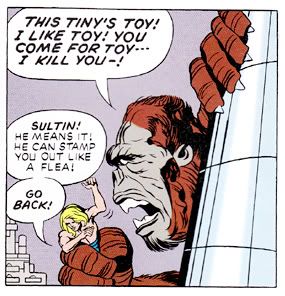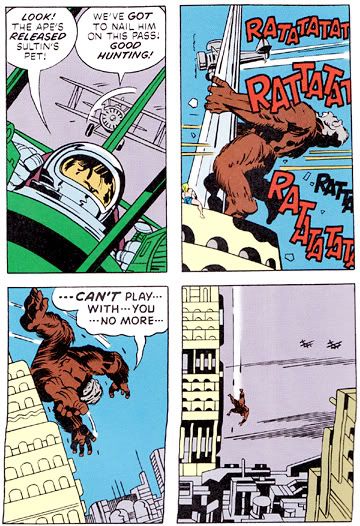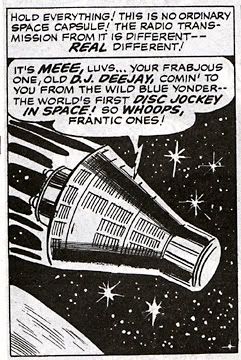
You may be too young to remember the days before genetically engineered super-comics grew on cybertrees in all the colors of the rainbow, but when I was your age they were made of paper. In 1975, DC's
Detective Comics consisted of 100 pages for 60 cents (I know! Imagine paying more than a quarter for anything less than 600 holographic pages!), and starred such iconic characters as Roy Raymond (subject of 1995's Oscar winner for Best Picture), Marty Moran (Headline Hunter) and Star Hawkins (in 1986, an act of Congress replaced Labor Day with a new holiday in Star's honor), plus those almost forgotten failures Batman and Robin, whose brief literary careers went nowhere-- aside from being occasionally unearthed and derided by nostalgia bloggers looking for obscure pop culture artifacts upon which to exercise their snide humor.
Yet at one point, this so-called Batman was a popular enough character to command the cover spot for a few issues of
Detective Comics. Then again, people living in those days also loved Irwin Allen's disaster movies and belted jumpsuits. There's no accounting for taste, or so they tell me. What do I know? I'm just a clone. From the future!
1974's Robin is quite a bit different from today's version, the wretched little asshole Damian Wayne. This Robin is the original one, Dick Grayson, better known now as... well, Robin, because I doubt most people outside of comics have ever heard of Nightwing, or of Grayson's stint as Batman. I also seriously doubt they even know the name Dick Grayson. It just doesn't stick in the mind like Bruce Wayne, Clark Kent, Roy Raymond, or Marty Moran (Headline Hunter).
Here we have young Robin as a college student at Hudson University, which sounds as though it should be located in upstate New York. And perhaps it is, because Robin and his university pals frequently pop over to Rutland, Vermont, for the annual Halloween parade. Almost once a year, in fact.
I'm not sure what kind of school Hudson University is. Ivy League? Big 10? One of the Seven Sisters? All "The Touchdown Trap" tells us is it's the 50th anniversary of the school's first football championship. Ah yes, Hudson University. It's coming back to me now, the legendary Hudson University football dynasty, when the school won 5 consecutive national championships.
But that was decades after the storied 1924 season, during which their offensive attack was spearheaded by Heisman Trophy winner, "Hurricane" Hurley. As our story begins, the school has invited back the offensive squad of that storied team to recreate the play that won them the league championship (the entire defensive team having died in the interim).
 The Hudson University Beavers play their home games before an appreciative crowd
The Hudson University Beavers play their home games before an appreciative crowd
of lumpy mashed potatoes turning gray with age.No student is more excited to see these aged gridiron warriors than our boy Dick. Hurley is an old family friend, and Dick is so thrilled to see him again, he's beaten up Jughead Jones of Riverdale and stolen his crown-like hat, then killed and skinned a goat and donned its still bloody pelt, steaming in the crisp autumn air. Hudson University, where goats are plentiful on campus and students gather around ukele-playing audioanimatronic figures to sing hymns to the coming socialist utopia.
 When 23-skidoo met far freakin' out.
When 23-skidoo met far freakin' out.
This is some nice dialogue. There's not the least bit of awkwardness in the way scripter Bob Rozakis has Hurricane Hurley reference his relationship to Bruce Wayne while addressing Dick by his full name and scholastic status. It's so natural and unforced, in fact, a lone cheerleader celebrates its soulful smoothness by soundlessly leaping into the air and shaking her pink pompoms. As good as his word, Dick takes straw-hat wearing Mr. Benson on a tour of the school's trophy hall. Benson's so impatient to see the trophys, he doesn't even want to drop of his bag. Or change his adult undergarments, which must be soaked after the long drive up from Gotham City. The man loves sports mementos and dampness in his personal area is not about to stop him from having fun. And it's a good thing, because as soon as Dick and Benson reach the hall, they find some fun-loving students engaged in a Hudson University tradition.
 This guy entered the fight wielding a sliver of balsa wood, or a canvas stretcher stolen from some poor art student's locker.
This guy entered the fight wielding a sliver of balsa wood, or a canvas stretcher stolen from some poor art student's locker.
Which is wearing white gimp masks and matching disco costumes to smash the award-laden glass displays. Careful! Those shards of glass might cut and the all the sports-related puns will stick to your shoes and make them smell something awful! Dick changes to Robin and beats up the disco kids, just as the campus cops show up. They're as timely and effective as most campus cops.
 For a second I thought I was dead. But, when I heard all the noise, I knew they were cops. Only cops talk that way. If they'd been wiseguys, I wouldn't have heard a thing. I would've been dead.
For a second I thought I was dead. But, when I heard all the noise, I knew they were cops. Only cops talk that way. If they'd been wiseguys, I wouldn't have heard a thing. I would've been dead.
"Okay, Robin... ...What the fudge is goin' on here?!" Only he didn't say "fudge." He said the "f-dash-dash-dash" word. Seems one of the "jocks" received a letter full of money with orders to smash up the trophy hall. Never one to question letters full of money, he and his friends immediately went out and spent their entire windfall on masks and matching leather jackets, then proceeded to wreak havoc. Now they're broke and in jail, but at least everyone knows they're together! A matching set. And that's what really counts. Togetherness. And Benson himself carves the roast-- actually, what Benson does is recover the game-winning football.
While Robin's trying to figure all this out, we cut to the stadium's locker room where the head coach from the 1924 squad is showing his team game film from their championship effort. Let's think about this for a moment.
 The old guys behind "Coach" are all smiling because, in his senility, he forgot to wear pants. Sports teams are notorious for their cruel, mocking humor.
The old guys behind "Coach" are all smiling because, in his senility, he forgot to wear pants. Sports teams are notorious for their cruel, mocking humor. The former players are all in their late 60s or early 70s. Their coach was probably in his 30s or 40s when they won the championship. Which means this guy is pushing 80 or perhaps even as much as 100 years old! Look at him! Time has left him a withered, toothless wreck of a man, and deposited a gigantic carbuncle on his chin. Yet he proudly wears a dirty old crewneck t-shirt upon the collar of which he's crudely lettered the word "COACH" in red marker. A younger man would have bought a nice sweatshirt with stitched lettering, or at least used iron-ons. But not this walking mummy. Look how high those letters are. This might be because artist Mike Grell didn't trust the readers to fill in the parts of the letters the bottom of the panel cut off, but that's not it. What happened is exactly as I've described it. It's in Rozakis's original script. Writers include little details like that in their scripts even though we'll probably never read them because it helps the artists figure out the characters they're drawing.
We get to see how the winning play went down. Hurley, the quarterback, took the snap from center, then turned to hand off to fullback Benson. With the pocket collapsing around him, he decided to keep the ball. The cameraman somehow managed to get a sweet close-up of that moment, so clear you can see the shock and disappointment on Benson's face when Hurley snatched the ball away from him. Then it's 90 yards down the field and he... could... go... Okay, yeah, we already know Hurley scored the winning touchdown.
A few minutes after the old coach passes away, the players take the field, wearing their original 1924 uniforms complete with leather helmets. Luckily, they've stayed in shape all those years and everything fits perfectly.
 Behind the men: a wall made of natural stone. Granite, I believe. With little flags poked into it to mark specimens of particular interest to rock hounds.
Behind the men: a wall made of natural stone. Granite, I believe. With little flags poked into it to mark specimens of particular interest to rock hounds.
The plan is to use the original game ball for the recreation, but someone has destroyed Hudson University's most precious sports artifact. Robin learns of this from none other than a time lost Burt Reynolds as he appeared in his starring role as police officer Nick McKenna in the 1993 cinematic masterwork
Cop and a Half.
 Robin never had a strong grasp of meteorological phenomenon. That's why he failed so many science classes.
Robin never had a strong grasp of meteorological phenomenon. That's why he failed so many science classes.At which point Robin deduces the reason for all the disco-style vandalism-- a distraction while someone switched footballs. And being a superb detective trained from childhood by the master himself, Batman, Robin also knows there was only one person in position to handle the old switch-a-roo. Hurley's in danger and there's not a moment to lose! After a trip to the concession stand for a large, icy Pepsi and one of those delicious Hudson University stadium chili dogs, then an interminable wait in the line an open urinal (millions in alumni donations for luxury skyboxes and a Jumbotron scoreboard, zero for restroom facilities), Robin leaps over the retaining wall and hurls himself down the field.
He takes Hurley down with a fine open-field tackle, snapping the man's brittle tibias and fibulae as though they were merely dried twigs, old wood, dead these many winters. The substitute ball contains a time bomb, as evidenced by the muffled ticking coming from within.
 "I don't care what kind of hero this moldy old chump used to be, ain't nobody crosses the goal line on Robin's field!"
"I don't care what kind of hero this moldy old chump used to be, ain't nobody crosses the goal line on Robin's field!"I'm left wondering why someone would use a timebomb in this situation. Wouldn't some kind of remote triggering device work much better? If you're a ball-handling offensive player on a football team-- a quarterback or fullback, for example-- chances are you're going to be near the football at some point during a play. Especially if your participation is a major component of said play. Granted this is merely a recreation, but the timing on these things isn't always precise. There are delays. These are old men; they don't move as quickly as they used to. Using a timed explosive is taking a major risk. But I don't know. I have a superstition about standing too close to explosions, so I may not be the most objective person to judge.
 Unfortunate timing led to the demise of all the doves released during the pre-game ceremony.
Unfortunate timing led to the demise of all the doves released during the pre-game ceremony.Forget all that! Not only is he a textbook tackler, but marvel at the height Robin gets with that punt! Lord have mercy! Imagine the hang time he'd have had if the ball hadn't contained a timebomb! Why isn't the current Hudson University coach trying to recruit this guy? "You can even wear the mask, kid, but we need you on special teams!"
I've been poking fun at "The Touchdown Trap," but it's really an effective eight-page story, with a concise, direct plot. Rozakis probably came up with it over lunch, ran it by editor Julius Schwartz and tapped it out on an IBM Selectric II at the DC offices in less than an hour, one of many he'd write that afternoon. Grell doesn't seem to have labored over the art-- and he obviously skimped on the stadium crowd shots. Lumpy gravy? Week-old grits? But you know what? That's fine. Rozakis and Grell weren't trying to produce a masterpiece. They were just trying to tell an entertaining Robin mystery to fill a slot in the magazine. Stripped of flash, efficient, not a wasted moment, no loose ends, just enough character development to propel the narrative to its conclusion.

Written today, "The Touchdown Trap" would attempt some gross-out thrills with a few gruesome murders. Also, it would consist of a four-issue prologue mini-series, then twelve issues running across most of DC's monthlies for an entire summer, and finally, a couple of epilogue stand-alone issues and a new on-going series starring the daughter of the original Roy Raymond, also named for some reason Roy Raymond. The real culprit behind it all-- manipulating Benson and Hurley for his own nefarious ends-- would be an insane Star Hawkins with help from a brain-damaged, drug-addicted Marty Moran (Headline Hunter). And as a parting gift, Robin would also learn Hurley had molested Benson's daughter and consequently come away a Boy Wonder disillusioned with hero-worship. A few months later, and we'd all get to buy the hardcover annotated version with an introduction by some
best-selling author of horror novels or techno-thrillers sold by the pound at airports, re-mastered art on super-slick glossy paper and self-congratulatory commentary from the creators. Two more years and there'd be the direct-to-DVD animated adaptation. Then the new
Roy Raymond title would be cancelled, she'd show up from time to time badly mischaracterized in various Batman-related books and finally, be raped and murdered as a minor plot element in yet another multi-title crossover event.
A relic of a simpler, brighter time, Rozakis's plot would've worked beautifully as a segment of
Super Friends or an episode of
The New Scooby Doo Movies guest-starring the Dynamic Duo, or the Caped Crusaders. Or Sonny and Cher. All that's missing is an unmasking. We have to settle for an unhelmeting. Actually, we don't even get that much. Poor Benson. Fifty years nursing a grudge and this is the best revenge he can come up with? Like Robin notes, "I guess some guys are just life-long losers!" Luckily for Benson, he won't have long to stay in prison. Because he's so old, he's bound to die there in a month or two! Freddie, Velma, Daphne, Shaggy, Scooby, Batman and Robin all laugh heartily and...
Roll credits.
 Summer is upon us and that means school's out, big-budget/small-brained blockbusters dominate the nation's movie screens, there's nothing on TV but reality shows and dramas too lame to make the regular season and people are putting down their hefty copies of James Joyce's Ulysses and picking up lighter reading fare. My suggestion?
Summer is upon us and that means school's out, big-budget/small-brained blockbusters dominate the nation's movie screens, there's nothing on TV but reality shows and dramas too lame to make the regular season and people are putting down their hefty copies of James Joyce's Ulysses and picking up lighter reading fare. My suggestion? Hot Acroyear-on-Acroyear action! Notice how Golden makes the character Acroyear look "real," but the anonymous enemy version looks like one of the Mego toys, complete with metal joints!
Hot Acroyear-on-Acroyear action! Notice how Golden makes the character Acroyear look "real," but the anonymous enemy version looks like one of the Mego toys, complete with metal joints!















































